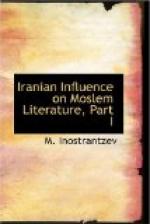We have demonstrated above that in the time subsequent to the Arab conquest Iranian tradition found a congenial asylum in the bosom of the Parsi priesthood. There it was maintained and developed orally as well as in a written form. The most competent among the Persian historians who employed the Arabic language in those times turned to the Parsi clergy for information. Of this we have first-hand proof in their own works and in the quotations from other works preserved in later authors. For example, they frequently remark “the Mobedan-mobed related to me”, “the mobed so and so told me” and so on. In their quest for ancient Persian books, too, Arab authors searched for them among the Parsi priesthood and it was only there that they found them. Thus it was the merit of the Parsi community that it conserved Iranian traditions daring unfavourable times and handed them on to Moslem Persia under more auspicious conditions.
Involuntarily we are led to a comparison, to their advantage, with the activity of the Iranophile party of the same times in the Moslem community, the party of the Shuubiya,[1] In their capacity as promoters of learning and exponents of literature they concentrated their activity in the cultured centre of the Khalifate at Baghdad and other cities, and being familiar with Persia played an important part in the development of Moslem culture of the Middle Ages. But in the preservation of the Iranian tradition they turned to much restricted and greatly exclusive Parsi circles. In the second half of the tenth century and in the eleventh century the currents which were preparing the Persian renascence party were lost and their significance forgotten. But for the purpose of illuminating historical questions a careful examination of these currents deserves our undivided attention. It was owing to them that literary materials were preserved which were sometimes direct translations from books belonging to the Sasanian period. The course by which these materials found their way into Arabic literature can be definitely traced. They came from Parsi centres through older circles of Moslem civilisation which were sympathetic towards Persia. Generally speaking they were trustworthy transmitters. As a matter of fact the Shuubiya turned only to the Parsi circles for materials and in the explanation of the material they did not distinguish them from their other sources. Their sources betray themselves by an exaggerated Parsi partiality where the penchant of these circles is clearly manifest. And these are intimately connected with certain questions of daily life,—the struggle for power between the Arab and the Iranian element in the Khalifate. Enthusiastic partisans of the Persian element, these circles as a counterblast to the poverty of civilizing factors of the pre-Islamic Arab nation, turned to the glories of Persia, principally of the Sasanian past. Iranophile writers had no need for inventions, since historical truth was on their side. The




